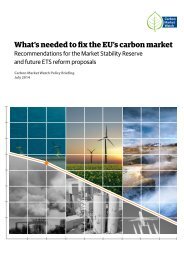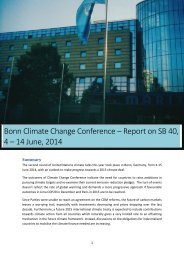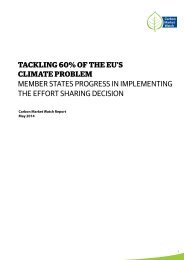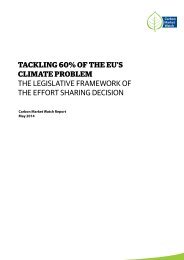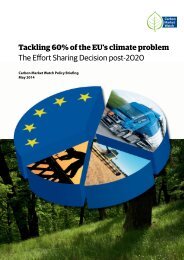Analysis of Europe’s 2030 Climate Ambition
Create successful ePaper yourself
Turn your PDF publications into a flip-book with our unique Google optimized e-Paper software.
Introduction<br />
During the night <strong>of</strong> 23 October 2014, EU leaders have brokered a deal on the <strong>2030</strong> climate and energy<br />
headline targets. EU’s Heads <strong>of</strong> States settled on an EU-binding renewable energy target <strong>of</strong> at least 27%,<br />
an indicative energy efficiency target <strong>of</strong> at least 27% and an at least 40% binding domestic greenhouse<br />
gas reduction target by <strong>2030</strong>.<br />
This deal setting out <strong>Europe’s</strong> future climate ambition has to be seen in the wider political context <strong>of</strong><br />
the international climate negotiations that are expected to deliver a global climate deal at the climate<br />
summit in Paris next year. The EU is one <strong>of</strong> the first in announcing its pledge for the future climate treaty,<br />
providing momentum for the rest <strong>of</strong> the world to follow suit. However, the EU’s climate target fails to<br />
be in line with the EU’s fair contribution to tackling climate change which would entail around 55%<br />
domestic emission cuts. This lack <strong>of</strong> ambition is largely caused by the current difficult political and<br />
economic climate landscape: The economic crisis has reduced the political willingness to adopt policies<br />
that are either seen as expensive or have a potential impact on industry’s competitiveness.<br />
Euroscepticism, on the other hand, has put a strain on the regulatory powers <strong>of</strong> the EU, favoring an<br />
(over)reliance on markets instead.<br />
Although the <strong>2030</strong> climate and energy package is centered around the greenhouse gas reduction target<br />
with little support from the renewable energy and energy efficiency pillars, a positive decision was to<br />
keep the option open <strong>of</strong> increasing the <strong>2030</strong> climate target at a later stage. But this outcome which<br />
required all 28 Member States to agree came at a price: Concessions were made to some countries in<br />
the form <strong>of</strong> energy subsidies and new flexibility instruments. Poland was the most vocal country<br />
threatening to use its veto to block the deal in case it was not sufficiently compensated financially.<br />
Poland succeeded in ensuring that its coal-dominated energy sector will remain shielded from the<br />
carbon price also in the future. Poland also ensured access to new subsidies by establishing a<br />
modernization fund that could potentially be used to extend the lifespan <strong>of</strong> its existing coal power<br />
plants. At the same, more wealthy countries with relatively high national reduction targets demanded<br />
new flexibility instruments to make sure they would not be faced with high costs. A new flexibility option<br />
was borne that allows these countries to buy allowances from the oversupplied carbon market in order<br />
to <strong>of</strong>fset emissions in the transport, building and agriculture sectors.<br />
In a nutshell, key highlights <strong>of</strong> decisions on the <strong>2030</strong> climate and energy framework include:<br />
1. A binding target to reduce domestic greenhouse gas emissions by at least 40% by <strong>2030</strong>,<br />
possibly resulting in only 31% effective emission reductions<br />
2. A possible revision <strong>of</strong> the EU’s pledge after the climate summit in Paris next year, opening<br />
doors for the EU to increase its climate ambition and participate in the international carbon<br />
market<br />
3. Flexibilities to help achieve Member States’ targets for the non-ETS sectors, including<br />
<strong>of</strong>fsetting non-ETS emissions with EU ETS allowances<br />
4. Continuation <strong>of</strong> free allocation <strong>of</strong> emission allowances to industry, worth €120-€300 billion<br />
5. Inclusion <strong>of</strong> land use, land use change and forestry (LULUCF) into the climate framework<br />
6. Financial support to the power sector in low-income states, including free allowances to<br />
power plants worth up to €11-€16.5 billion and a modernization fund worth €6-€9 billion<br />
See below a more detailed analysis <strong>of</strong> these decisions and possible next steps:<br />
1










